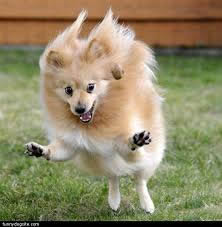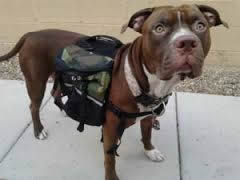We routinely see hyperactive dogs. Though these dogs are difficult to work with and train, it can be done and made easier if we look at the many possible causes, and implement solutions.
Many hyperactivity problems stem from the dog’s boredom and a lack of stimulation. In order to address these issues, you have to assess the way you are interacting with a dog and the kind of activity your dog gets on a daily basis.
 Because dogs seek attention from you, paying attention to the hyperactive dog during outbursts only reinforces the behavior that you’re trying to eliminate. The solution – if you have a hyperactive dog jumping or nipping at you in an overexcited way, ignore him and walk away. If you are walking, stop and stand still. You might be surprised how quickly the dog settles down.
Because dogs seek attention from you, paying attention to the hyperactive dog during outbursts only reinforces the behavior that you’re trying to eliminate. The solution – if you have a hyperactive dog jumping or nipping at you in an overexcited way, ignore him and walk away. If you are walking, stop and stand still. You might be surprised how quickly the dog settles down.
If a dog lacks stimulation and exercise, the result is often hyperactivity. Taking a dog on two 45 minute structured leash walks daily helps tremendously. The walk helps the dog focus on just walking beside you. If you ask a dog to sit at crosswalks and driveways, it stimulates the dog even further. You can also have the dog wear a backpack on your walks. The extra weight helps keep him focused on carrying instead of getting distracted by squirrels and other interesting things. It also drains any pent up energy he may be storing. Giving your dog a task to focus on helps in satisfying his needs and draining his energy.
 Hyperactivity in dogs can also arise from psychological needs. This is why giving the dog a job to do is so important; you are removing his hyperactive dog behavior and redirecting his energy elsewhere. By redirecting an overexcited dog’s energy from inappropriate behaviors like jumping up, to appropriate behaviors like a sit-stay, you are creating a job. This can be achieved by having an overexcited jumper learn to earn all things of value including food, toys, treats and affection with a sit-stay. This should include all greetings. Have as many people as possible throughout the day help train this dog to sit.
Hyperactivity in dogs can also arise from psychological needs. This is why giving the dog a job to do is so important; you are removing his hyperactive dog behavior and redirecting his energy elsewhere. By redirecting an overexcited dog’s energy from inappropriate behaviors like jumping up, to appropriate behaviors like a sit-stay, you are creating a job. This can be achieved by having an overexcited jumper learn to earn all things of value including food, toys, treats and affection with a sit-stay. This should include all greetings. Have as many people as possible throughout the day help train this dog to sit.
Dogs mirror your energy, so it’s important you realize what you are projecting. If you are in an overexcited state of mind while handling a hyperactive dog, this can be a recipe for disaster. Any interaction is a coaching opportunity to teach a dog to behave in a calmer way.
If you are stressing out over an argument or burdened with the worries of the work week, these nervous or anxious moods translate into nervous or anxious body language or tones of voice. This affects the energy of your dog. When you are working with these hyperactive behaviors, relax and stay focused.
In the shelter situation, try to reduce the presence and absence contrast of arriving and leaving. For five minutes after you arrive at a kennel and 10 minutes before you leave, completely ignore any anxious dogs you are working with. This means no eye contact, no speaking, no touching, and no fast noisy activity. We do not want these dogs to think of and associate your arrival with excitement. This leads to overexcited greetings.
We can also use desensitization techniques to help reduce the reaction a dog has to certain stimuli. For example, if just the act of touching a leash makes the dog go through the roof with excitement, make picking up the leash a part of everyday life. This means you should practice walking to the leash, picking it up, putting it back down again, and walking away. Don’t follow it with a walk. Do this routine over and over again while ignoring the dog.
You’ll eventually notice the dog becoming less stimulated by the leash. We call this becoming desensitized. You can use this desensitization technique for any exciting stimulus or activity. The trick is to practice the exercise frequently enough that the dog learns to not associate it with excitement.
Aromatherapy can be a helpful tool that is both holistic and natural. It works well because dogs experience the world primarily by scent. Just as the smell of lavender is said to relax human beings, a soothing smell can also have a very calming effect on the dog. Talk to your veterinarian to find out what smells may work for a dog. Aromatherapy can be applied to a bandana that the dog can wear, the kennel area, on their bedding where they sleep, on you, and even rubbed on the muzzle of the dog.
This article was taken from a free shelter and rescue course available at the Academy For Canine Educators
Dr. Louise Janes D.V.M. & Dr. Jeff Grognet D.V.M.
 Mid-Isle Veterinary Hospital
Mid-Isle Veterinary Hospital
5-161 Fern Road West
Qualicum Beach, BC
Tel (250) 752-8969
See all articles by Dr. Louise Janes D.V.M. & Dr. Jeff Grognet D.V.M.



